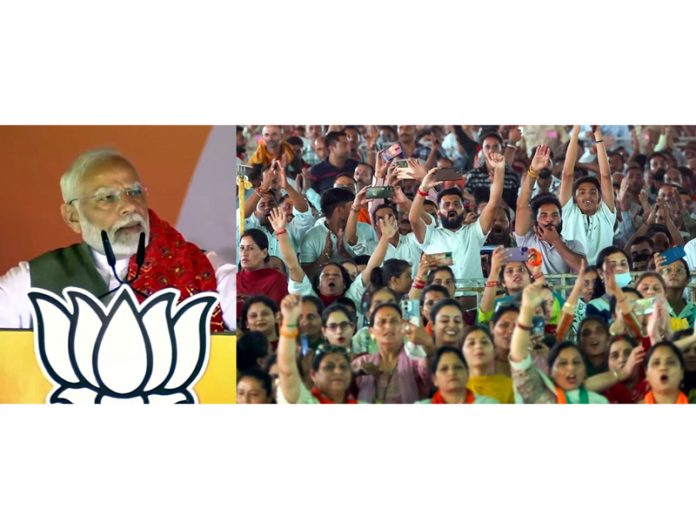
In today’s times, we all witness climate crises in some form or another in our daily lives. The climate emergency is undeniable, and its impacts are far from being evenly distributed. The marginalised communities, especially women and girls, are most vulnerable to the consequences of the climate crisis due to lack of agency in placing their demands, needs and voices as a result of deep-rooted socio-cultural and economic norms.
While there's growing acknowledgement of this gender inequity across the board, there is not enough prioritisation, as reflected in our climate actions and policies. However, not building centrality around women and girls in climate-related conversations and decisions is a situation that India cannot afford. This is because of two key factors: First, with women comprising over 45% of our population, the intersection of gender and climate can have deep consequences.

Second, realising Prime Minister Narendra Modi's vision of women-led development as a cornerstone of Viksit Bharat requires addressing women's vulnerability to the climate crisis. Integrating their perspectives into India's policy framework is essential for effective and inclusive climate action. Historically, women have played a key role as primary caregivers and food producers in India, especially in marginalised communities and in rural India.
This endangers them with the vulnerabilities of the impacts of the climate crisis, leading to physical, mental, and emotional stress. For example, in the agriculture sector--nearly 75% of rural women are engaged in agriculture as labourers or small-scale farmers. They are directly affected by climate-driven reductions in crop yields, resulting in financial distress and its ripple effects.
Data from the National Family Health Survey (NFHS) 4 and 5 highlights that these situations exacerbate food insecurity, particularly among already nutritionally deficient poor households. The consequences for women in these households are severe—they face increased domestic work burdens, deteriorating health with no priority given to their well-being over that of the men in the family, and a rise in intimate partner violence. Girls in such households have a higher prevalence of child marriages compared to those in non-drought or climate-affected districts.
This underscores the challenges of the critical intersection of gender and the climate crisis and the need to centre our actions and approaches through a gender lens. Over time, India has made substantial changes to its climate priorities and policies to address the broader implications of the climate crisis. However, women’s unique vulnerabilities, perspectives and contributions largely remain underrepresented in decision-making processes.
For instance, the National Action Plan on Climate Change (NAPCC) does not specifically address mitigation and adaptation strategies through a gender lens. While out of its eight missions, some recognise the disproportionate impact of the climate crisis on women, especially in rural areas, and their participation in climate adaptation, it just does not add up, given the enormity of the issue and the huge implications it can have on India’s developmental goals and vision for becoming a developed nation. When you look at states, a few have started incorporating gender considerations into their State Climate Action Plans.
For instance, Kerala's SAPCC highlights women's roles in climate action, especially in agriculture and disaster management. Madhya Pradesh also recognises that women are impacted differently by climate and emphasises the significance of gender-sensitive methods in mitigation and adaptation plans. The SAPCC for Odisha emphasises how women are particularly vulnerable to the effects of the climate crisis and focuses on gender-sensitive adaptation measures, particularly in agriculture and water management.
However, the point remains that working in silos will not yield outcomes that truly matter. The lack of focus on gender-sensitive policies and financing across climate intersectional sectors, such as water, agriculture, energy, and forest management, at the central and state levels needs attention and intervention. A critical enabler of success in gender-inclusive climate action planning and financing is a robust inter-ministerial collaboration that can effectively support the policy-to-action journey and offer supportive resources and infrastructure to build women's capacities, including promoting women’s leadership in climate governance.
Gender-based analysis across these intersectional sectors is required to understand the differential impacts of the climate crisis on diverse groups, especially women, and accordingly inform policymaking. These insights can help shape budgetary allocation for designing and implementing programmes that ensure women’s participation in decision-making, resource management, and climate resilience efforts. The country’s commendable vision for women-led development also highlights the need to view women as beneficiaries of development programmes as much as active participants, decision-makers, leaders and agents of change.
While investing in women’s empowerment and leadership is a non-negotiable in the larger India growth story, it is also critical in climate action. This presents a great opportunity for India to take the lead and focus on integrating programmes at the education, skilling, and community levels that sensitise girls and women about the climate crisis and its irreversible impact on them. More importantly, show them pathways to lead solution-finding—for example, supporting them to become innovators and entrepreneurs in climate-friendly products and services, be it sustainable textiles, organic farming, and clean energy.
This includes giving women access to education, resources, and opportunities to participate in decision-making processes. As a result, we can enhance their resilience to the climate crisis and allow them to contribute more effectively to climate solutions. This approach will enable mechanisms to promote women's leadership, contributing to economic growth and climate action.
This will also become a key enabler to realising India’s aim to become a green economy. This article is authored by Suryaprabha Sadasivan, senior vice-president, Chase India..










